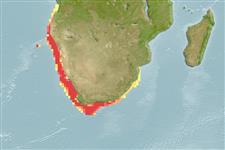Environment: milieu / climate zone / depth range / distribution range
Ecología
marino batidemersal; oceanodromo (Ref. 51243); rango de profundidad 50 - 1000 m (Ref. 27121), usually 150 - 450 m (Ref. 27121). Deep-water; 11°S - 37°S, 5°E - 33°E (Ref. 58452)
Southeast Atlantic: Baie Farte, Angola around Cape to Natal, South Africa. Also found on Valdivia Bank (26°18'S, 6°20'E).
Length at first maturity / Tamaño / Peso / Age
Maturity: Lm 47.4 range ? - ? cm
Max length : 140 cm TL macho / no sexado; (Ref. 6605); common length : 50.0 cm TL macho / no sexado; (Ref. 1371)
Espinas dorsales (total) : 1; Radios blandos dorsales (total) : 47 - 54; Espinas anales: 0; Radios blandos anales: 37 - 41. Light brown above, silvery to white below (Ref. 6605).
Found on the continental shelf and slope to depths over 1,000 m (Ref. 27121). Juveniles (to about 64 cm) feed on small crustaceans and small deep-sea fishes such as lanternfishes, whereas larger individuals feed chiefly on small hakes and jack mackerel (Ref. 1371); cannibalism is common (Ref. 27121). Migrates southward in the spring and northward in autumn (Ref. 1371). Breeds throughout the year, peaks of reproductive activity in August and September (Ref. 36731). Marketed smoked, frozen, and fresh on ice; eaten steamed, fried and baked (Ref. 9988).
Life cycle and mating behavior
Madurez | Reproducción | Puesta | Huevos | Fecundidad | Larva
Cohen, D.M., T. Inada, T. Iwamoto and N. Scialabba, 1990. FAO species catalogue. Vol. 10. Gadiform fishes of the world (Order Gadiformes). An annotated and illustrated catalogue of cods, hakes, grenadiers and other gadiform fishes known to date. FAO Fish. Synop. 125(10). Rome: FAO. 442 p. (Ref. 1371)
IUCN Red List Status (Ref. 130435: Version 2024-1)
Threat to humans
Harmless
Human uses
Pesquerías: escaso valor comercial
Herramientas
Special reports
Download XML
Fuentes de Internet
Estimates based on models
Preferred temperature (Ref.
123201): 7.7 - 14.4, mean 10.2 °C (based on 78 cells).
Phylogenetic diversity index (Ref.
82804): PD
50 = 0.5000 [Uniqueness, from 0.5 = low to 2.0 = high].
Bayesian length-weight: a=0.00513 (0.00339 - 0.00775), b=3.11 (2.98 - 3.24), in cm total length, based on LWR estimates for this species & Genus-body shape (Ref.
93245).
Nivel trófico (Ref.
69278): 3.9 ±0.65 se; based on food items.
Generation time: 9.2 (7.9 - 12.1) years. Estimated as median ln(3)/K based on 21
growth studies.
Resiliencia (Ref.
120179): Bajo, población duplicada en un tiempo mínimo de 4.5-14 años (K=0.07-0.13).
Fishing Vulnerability (Ref.
59153): High to very high vulnerability (67 of 100).
Climate Vulnerability (Ref.
125649): Very high vulnerability (86 of 100).
Nutrients (Ref.
124155): Calcium = 6.55 [3.45, 22.85] mg/100g; Iron = 0.282 [0.055, 0.771] mg/100g; Protein = 16.8 [15.7, 18.1] %; Omega3 = 0.123 [0.066, 0.231] g/100g; Selenium = 32.1 [14.4, 77.4] μg/100g; VitaminA = 9.09 [1.90, 42.59] μg/100g; Zinc = 0.225 [0.151, 0.358] mg/100g (wet weight);
